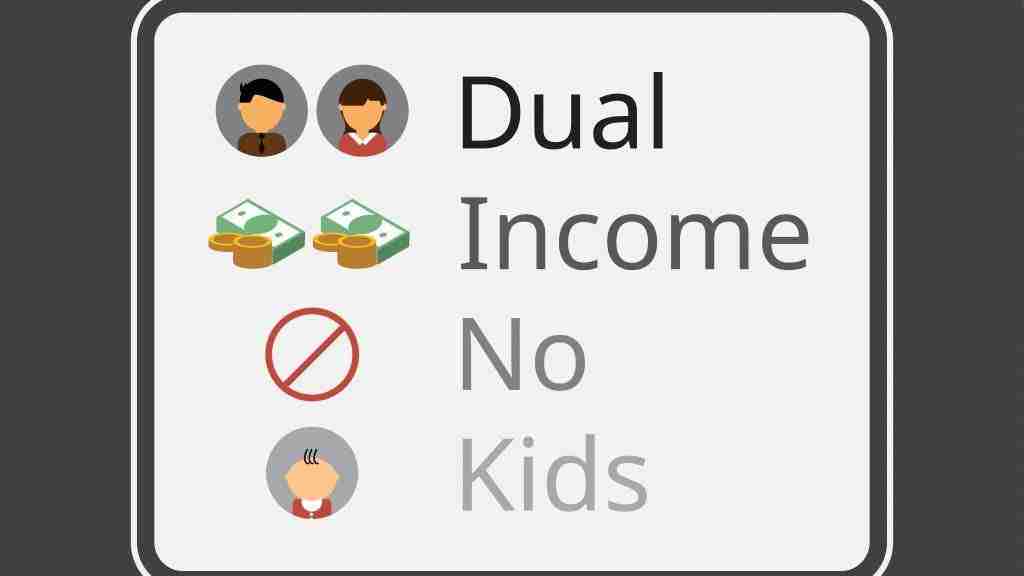Many Millennial couples opt to live a lifestyle that involves not having or delaying having children. At the same time, both partners hold full-time jobs, also known as DINKs (Dual Income No Kids).

Let’s look at what it means to lead a DINK lifestyle, how it started, and if it is the right choice for you and your partner.
What Does The Term DINK Mean?
DINK stands for Dual Income No Kids. The term commonly describes a childless couple, usually married. And because their earnings are part of the same household, they often have more discretionary income than couples with children.
The term DINK is common within the personal finance space, most commonly associated with white-collar couples.
Types of DINKS
New Couples
New couples are the most common type of DINKs since they are just starting their life together and are unlikely to have a family yet. When a new couple combines their finances, they often have a considerable additional cash flow because they live within the same household. Expenses that were solely the responsibility of one person, such as rent, utilities, car payments, and maintenance, are now split between two people.
Empty Nesters
While empty-nesters have children in the literal sense, their children are likely adults and moved on to start their own lives and families. When you become an empty nester, it’s essential to consider using any additional income to beef up your retirement plan. After age 50, you can contribute up to $26,000 to a 401(k) or 403(b) plan.
Why Are DINK Couples Becoming More Popular?
3 main factors are attributed to more couples choosing the DINK Lifestyle.
Marriage Rate
Being childfree was quite unusual in the 1950 and 1960s. This was due to many factors, mainly the marriage rate and post-WWII desire to return to normalcy. In 1967, the marriage rate was nearly 80%. However, the marriage rate has slowly declined over the decades, dropping to an astoundingly low rate of 33% in 2020.
One partner worked full-time while the spouse stayed home, where their main job was raising children and maintaining a home. During this period, it was easy for a middle-class family to maintain a comfortable lifestyle while only one person maintained a full-time job. For example, in 1965, the average CEO to worker compensation was only 20-1 according to the Economic Policy Institute.
This brings me to my next point leading to the rise of DINK couples…
Increasing Income Inequality
In the 1980s, an idea emerged that a company’s primary goal should maximizing shareholder value, not focus on all stakeholders. In other words, employees came second to increasing a company’s share price.
One could attribute that emerging ethos to globalization or Reganomics and its associated reforms (deregulation) that occurred during that time.
Pushed aside were the interests of all stakeholders. Executives became obsessively focused on maximizing shareholder value. They did this by cutting jobs, spinning off unprofitable divisions, and outsourcing labor to cheaper locations, among other ways.
Not coincidentally, the average CEO pay has increased over 1,000 % vs. 12% for the average worker between 1978 and 2018.
The point is very relevant because the idea of a one-income household to sustain a family has faded from the American reality. Now, more couples are finding a dual-income household is needed to maintain their quality of life.
Student Loan Debt Burden
Student loan debt is now the second-largest source of debt for Americans, just behind mortgage debt and ahead of credit card debt. Nearly 1 in 8 Americans have student loan debt, according to the Brookings Institute.
And as more and more students take-on student loan debt, they realize paying back a substantial debt burden is becoming nearly unmanageable. Case in point, the debt burden in the U.S. ballooned to $1.5 trillion in 2020, up from $250 billion in 2004!
Not surprisingly, when coupling massive student loan debt with a declining marriage rate and rising income inequality, it makes sense to see more couples choosing the DINK lifestyle as the only manageable path forward.
Daily Life as A DINK Couple
According to USDA, the cost of raising a child in a middle-class family can total nearly $233,000, or approximately $13,000 per year, not including college expenses. Indeed not a small sum for any couple!
Alternatively, if you took that same amount and invested $13,000 annually for 18 years, assuming 7% annual returns, you would have over $500,000! Raising just 1 child can cost 2X more than the average American has saved when they reach retirement age!
Plus, everyday richness such as eating out more frequently, luxury vacations, designer clothes, and high-end cars, among other lifestyle accouterments, are some of the things high-earning DINK couples may more regularly enjoy.
However, even if you are a DINK couple, the dual-income household may not always go as far as you think due to a multitude of reasons such as:
- Location (High-Cost of Living cities like New York or San Francisco)
- Lifestyle (If you spend all your money on luxury items, you may end-up in a worse position financially)
- Salary (If you are an average income earner, a dual-income may be necessary. Especially if you live in a HCOL city.)
Leading a DINK lifestyle allows for a way of living that includes more free time to pursue hobbies, and exercise, less need for planning, reduced stress, and more bonding time with your significant other. Alternatively, having children creates bonding and memories that many also considerable immeasurable beyond one’s free time.
Money Management Tips For DINKs
Despite having a dual income and lower expenses, a DINK couple should still make wise personal finance decisions to make the most of their situation.
Regularly Contributing To Your Retirement Account
Regular contributions to retirement accounts are the easiest and the most surefire way to build wealth for all Americans. The maximum tax-deferred contribution amount in 2021 for a 401(k) and 403(b) is $19,500.
Having A Realistic Plan To Manage Your Debt
In general, you should avoid most high-interest debt, such as consumer debt. However, if you have credit card debt, student loans, or any other type of debt, you need to have a strategic plan to pay down the balance.
The two common debt reduction strategies are the Avalanche Method and the Snowball Method.
The Debt Snowball Method involves paying off your smallest debts first regardless of the interest rate. I consider this the low-hanging fruit.
Alternatively, The Debt Avalanche Method involves making required minimum payments and then using extra cash to pay down the highest interest debt first.
Purchase Life Insurance
Even if you currently don’t have children, being adequately insured is one of the most overlooked areas of personal finance.
I cannot stress this point enough.
Even with a household of two, you should still carry proper Life Insurance, especially if you have significant expenses such as a mortgage and car payments.
With an insurance policy from Ladder, you can easily apply to increase or decrease your policy amount as your needs change.
This unique feature is only offered by Ladder and can be very beneficial if you later decide you no longer want to live the DINK lifestyle and need to adjust your policy accordingly.
How To Plan For A Life Without Children
Most couples spend their golden years around quality time with grandchildren and enjoying their retirement savings. But if you do not have children, there are additional considerations DINK couples should think about carefully. For example:
- Estate Planning. Who will they leave their estate to when they pass away? It is essential to have a Will to avoid any disputes. Will & Trust digitalizes the entire process and makes Will planning a breeze.
- How they will spend their years in retirement (Increased traveling, visiting friends and family members)
- Elder Care. Who will take care of them when they are older? According to Pew Research, about 23% of adults aged 45-64 care for an aging adult. And with the daily cost of homecare up costing up to $350, this is something DINK couples need to plan for wisely.
PROs and CONs of the DINK Lifestyle
PROS
- Increased discretionary income
- More time to establish and focus on your career
- Additional free time
- Cheaper healthcare
- Extra money to save and invest
- More personal mobility – e.g., housing and ease of travel
- Fewer lifestyle restrictions, e.g., type of car, housing size, socializing with friends
CONS
- Inability continue your legacy
- The immeasurable joy of seeing your children grow
- Less family support as you age
- Tax Breaks (The IRS often provides considerable tax breaks for families)
The Bottom Line: Is Being a DINK Worth It?
There are certain monetary benefits to choosing a DINK lifestyle. Starting and raising a family creates “wealth” that goes beyond dollars and cents. A family creates memories, joy, bonding – innate human experiences that cannot be measured financially.
And when it’s all said and done, money is a tool, not a means to an end.
The numbers eventually just become more digits on a screen.
What is important to remember is the legacy we will leave behind when our time comes to an end.
Not the legacy of being known as the rich aunt or uncle or godmother or godfather.
But the legacy of who we were as individuals.
That is something no amount of money can measure and one should consider carefully before choosing the DINK lifestyle.
Do you think the DINK lifestyle makes sense? Comment below and let the RWPF audience know!

